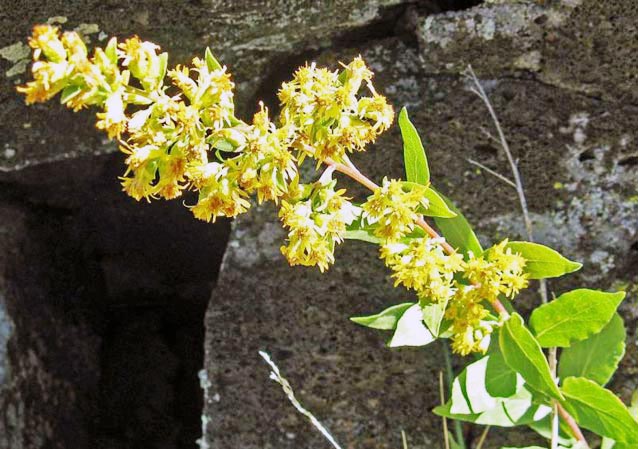Capulin Volcano National Monument is located within a vegetative transitional zone between the Rocky Mountains and shortgrass prairie, resulting in a relatively high diversity of habitats for wildlife and plants not found elsewhere in the surrounding grasslands. Capulin goldenrod is a rare plant found at the monument and was first described and collected in 1936 by Cockerell and Andrews.
Capulin goldenrod (Solidago capulinensis) has not been included in any subsequent account of the New Mexico or United States flora. It was rediscovered at the Pueblo Colorado Nature Center in Pueblo, Colorado, which prompted a new survey within the monument in September of 2010 by Dr. Tim Lowrey of the Museum of Southwestern Biology at University of New Mexico. Dr. Lowrey found Capulin goldenrod growing throughout the monument and re-identified it as a rare endemic plant. It is the only known rare vascular plant species in the monument.

Tim Lowrey / NPS
Status and Trends
Only two floristic surveys exist for the monument; Parmenter at al. (2000) conducted a rare-species inventory and Johnson et al. (2003) completed a comprehensive floristic survey. Results from both surveys reported no rare plants found within the monument. Between 2005 and 2009, Natural Heritage New Mexico completed a vegetation classification and mapping project for the monument. Plant species were recorded from within vegetation plots but did not include Capulin goldenrod. The intention of the Natural Heritage study was to detect dominant plant species, not to conduct a detailed floristic survey that would detect rare species. To date, two informal surveys have been conducted to specifically document the presence of Capulin goldenrod in the monument, however, its abundance and distribution are not well known at this time.
Discussion
Rare plants have a mystique about them that perhaps more abundant plants don’t possess. It is most likely due to the fact that they are different from the surrounding plants and that rare plants have evolved in a unique way, responding to environmental influences unlike any other species. Rare plants tend to have narrow geographic ranges, restricted habitats, and small populations. These factors can sometimes limit knowledge of rare plant ecology and potential threats to these plants making them challenging to manage. Local planning and conservation efforts become more important for understanding such a rare species and ensuring its continued survival.
For More Information
Bennetts, R. E., K. Struthers, P. Valentine-Darby, T. Folts, H. Sosinski, and E. Yost. 2011. Capulin Volcano National Monument: Natural Resource Condition Assessment. Natural Resource Report NPS/SOPN/NRR—2012/492. National Park Service, Fort Collins, Colorado.
Prepared by the Southern Plains Network Inventory and Monitoring Program, 2012.
Last updated: July 23, 2015
